
Shared posts
Scanning Tumblr, looking for the brands you use
Tumblr is an immense sea of valuable, publicly available user data just waiting to be tapped by marketers interested in how the cool internet teens use their products—just search “Starbucks” to see what I mean.
Tumblr, it seems, is also ready to help corporations cash in on its users’ impeccably curated tastes. It just inked a deal with Ditto, a company that scans images on the web for branded products and sells the results to multinationals like Coca-Cola and Kraft, and part of the deal involves giving Ditto wholesale access to all of Tumblr’s (which is to say Tumblr users’) photos.
"Twitter and Instagram have been suppliers of data to us for over a year and we’re able to look on behalf of brands at what the conversation about them looks like through photos," David Rose, CEO of Ditto, told Motherboard. “What’s different about Tumblr is that they’re supplying us with the entire firehose of all photos that we’re then able to interpret.”
Ditto’s algorithm identifies products that it’s been trained to recognize via a machine learning process, as well as indicators of users’ feelings towards the brand like a smile or a frown. By picking out the brands or goods said product is paired with in a given image, Ditto builds maps of product affiliations.
"We look at every photo, and we look for about 2,500 things in every photo," Rosin explained. "We’re primarily doing a pattern-matching algorithm that is matching brands and products that we have taught the system about. We’re looking for the presences of faces, and the expressions of faces, but not for individual people."
Though the system doesn’t necessarily identify individuals in their corporeal form, it can pinpoint the top influencers on a given social network and give their online identities to companies looking to partner with their biggest fans in promotional campaigns.
To get a sense of how the system works in real-time, you can view a live stream of images sourced from the web being scanned for brands on Ditto’s website. As images fly across the screen, the algorithm singles out any brand logos and human faces. The images are paired with information like the user’s handle and click through to their personal accounts….
"When I close my laptop, it goes to sleep. It’s a curiously domestic metaphor but it also implies..."
When I close my laptop, it goes to sleep. It’s a curiously domestic metaphor but it also implies that sleep in humans and other animals is just a kind of low-power standby mode. (Do computers dream of electric sleep?) Last year, Apple announced a twist on this idea: a new feature for the Mac operating system called “Power Nap”. Using Power Nap, your computer can do important things even while asleep, receiving updates and performing backups.
The name Power Nap comes from the term describing the thrusting executive’s purported ability to catch a restorative forty winks in 20 minutes but the functioning of Apple’s feature symbolically implies a yet more ultra-modern and frankly inhuman aspiration: to be “productive” even while dozing. It is the uncanny technological embodiment of the dream most blatantly sold to us by those work-from-home scams online, which promise that you can “make money even while you sleep”.
Sleep, indeed, is a standing affront to capitalism. That is the argument of Jonathan Crary’s provocative and fascinating essay, which takes “24/7” as a spectral umbrella term for round-the-clock consumption and production in today’s world. The human power nap is a macho response to what Crary notes is the alarming shrinkage of sleep in modernity. “The average North American adult now sleeps approximately six and a half hours a night,” he observes, which is “an erosion from eight hours a generation ago” and “ten hours in the early 20th century”.
Back in 1996, Stanley Coren’s book Sleep Thieves blamed insufficient rest for industrial disasters such as the Chernobyl meltdown. Crary is worried about the encroachment on sleep because it represents one of the last remaining zones of dissidence, of anti-productivity and even of solidarity. Isn’t it quite disgusting that, as he notices, public benches are now deliberately engineered to prevent human beings from sleeping on them?
While Apple-branded machines that take working Power Naps are figured as a more efficient species of people, people themselves are increasingly represented as apparatuses to be acted on by machines. Take the popular internet parlance of getting “eyeballs”, which means reaching an audience. “The term ‘eyeballs’ for the site of control,” Crary writes, “repositions human vision as a motor activity that can be subjected to external direction or stimuli … The eye is dislodged from the realm of optics and made into an intermediary element of a circuit whose end result is always a motor response of the body to electronic solicitation.”
You can’t get more “eyeballs” if the people to whose brains the eyeballs are physically connected are asleep. Hence the interest – currently military; before long surely commercial, too – in removing our need for sleep with drugs or other modifications. Then we would be more like efficient machines, able to “interact” with (or labour among) electronic media all day and all night. (It is strange, once you think about it, that the phrase “He’s a machine” is now supposed to be a compliment in the sporting arena and the workplace.)
”- "24/7: Late Capitalism and the Ends of Sleep" by Jonathan Crary: Sleep is a standing affront to capitalism | New Statesman
artnouveaustyle: missolivialouise: Here’s a thing I’ve had...

Art by Owen Carson

That's right, I drew a Solarpunk punk

Lolita Nouveau!

Art by Imperial Boy
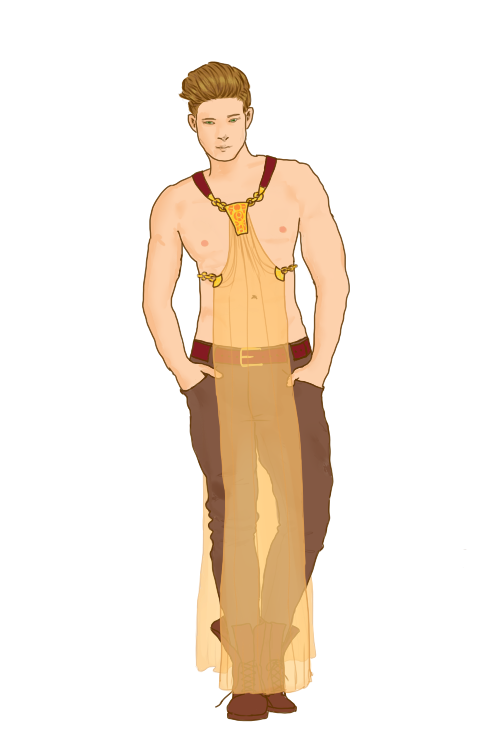
Mucha drew a loooot of topless ladies in flowy half-garments, so I decided to put a similiar kind of thing on a guy



The Cosmovitral in Mexico

Here’s a thing I’ve had around in my head for a while!
Okay, so I’m pretty sure that by now everyone at least is aware of Steampunk, with it’s completely awesome Victorian sci-fi aesthetic. But what I want to see is Solarpunk – a plausible near-future sci-fi genre, which I like to imagine as based on updated Art Nouveau, Victorian, and Edwardian aesthetics, combined with a green and renewable energy movement to create a world in which children grow up being taught about building electronic tech as well as food gardening and other skills, and people have come back around to appreciating artisans and craftspeople, from stonemasons and smithies, to dress makers and jewelers, and everyone in between. A balance of sustainable energy-powered tech, environmental cities, and wicked cool aesthetics.
A lot of people seem to share a vision of futuristic tech and architecture that looks a lot like an ipod – smooth and geometrical and white. Which imo is a little boring and sterile, which is why I picked out an Art Nouveau aesthetic for this.
With energy costs at a low, I like to imagine people being more inclined to focus their expendable income on the arts!
Aesthetically my vision of solarpunk is very similar to steampunk, but with electronic technology, and an Art Nouveau veneer.
So here are some buzz words~
Natural colors!
Art Nouveau!
Handcrafted wares!
Tailors and dressmakers!
Streetcars!
Airships!
Stained glass window solar panels!!!
Education in tech and food growing!
Less corporate capitalism, and more small businesses!
Solar rooftops and roadways!
Communal greenhouses on top of apartments!
Electric cars with old-fashioned looks!
No-cars-allowed walkways lined with independent shops!
Renewable energy-powered Art Nouveau-styled tech life!Can you imagine how pretty it would be to have stained glass windows everywhere that are actually solar panels? The tech is already headed in that direction! Or how about wide-brim hats, or parasols that are topped with discreet solar panel tech incorporated into the design, with ports you can stick your phone charger in to?
(((Character art by me; click the cityscape pieces to see artist names)))
Plz bring back art nouveau design in everything *_*
*I like it when people just make up entire cultural sensibilities
Stanford researcher: Hallucinatory 'voices' shaped by local culture
"Stanford anthropologist Tanya Luhrmann found that voice-hearing experiences of people with serious psychotic disorders are shaped by local culture – in the United States, the voices are harsh and threatening; in Africa and India, they are more benign and playful. This may have clinical implications for how to treat people with schizophrenia, she suggests."
The Mudang's Dance - Issue #1 - Compass Cultura
"In Korea’s case, the spaceship launched in 1963 and it flew much faster, and arrived (in economic terms, at least — the only terms apparently relevant to Park) sometime around 1995 or 1996, disgorging most of the same passengers who’d first boarded it (plus their kids) into an alien world. In less time than it took Americans to go from the first muscle car to the Prius and the Humvee, Koreans went from ox-and-plow to bullet train; from mountaintop signal fires to cell phones and free webmail."
algopop: Secret Messaging service found in Google...


Secret Messaging service found in Google Translate
Security researchers have discovered that strange variations of latin words from the Cicero ‘Lorem Ipsum’ text translate into totally unexpected sentences using Google Translate. Google have now hard-coded the algorithm NOT to translate the words Lorem and Ipsum, but from my tests you can still create secret messages using other Latin words. Suspiciously a lot of the variations produce sentences with the words - China, Russia, Network, NATO, and so on. Since Google translation algorithms learn autonomously through Machine Learning the researchers believe that someone has gamed the system to make it learn this instead. I guess they may have done this by surreptitiously feeding Google with latin/secret language texts.
Amazon to trial PrimeAir drone delivery service in India | sUAS News
"If everything goes well, the loud buzz of drones will drown the noise of crackers this Diwali in Mumbai and Bangalore, thanks to Amazon."
"I miss dinosaurs." "Evolution, we’ve talked about...

"I miss dinosaurs."
"Evolution, we’ve talked about this."
"But I miss them.”
"You turned them into birds, remember? It was the best you could do, given the circumstances.”
"It’s not the same."
"I know. I’m sorry."
"Can I at least make these cassowaries 50 feet tall?"
"Come on, you know that size didn’t work out so well before."
"Six feet, then? And over 100 pounds?"
"Yeah, that sounds better."
"And can I put weird prehistoric crests on their heads?"
"I don’t see why not."
"And can they slash people’s throats with their dagger claws?”
"Sure, pal, if that would make you feel better."
"I think it would. Thanks for understanding."
"You got it, evolution. Anytime."
Sound Of Net
There are lightbulbs that are also wireless bluetooth speakers. Imagine being able to send robot text to one. A lightbulb that quietly recites The Shipping Forecast, or Dark Sky local rain alerts, or pings from the IFTTT Space Channel that tells you when an astronaut goes into orbit, or calendar tasks or any number of things. One of the many things I wish I knew how to make. I stopped being able to parse code somewhere between HTML 2.0 and CSS. It may be just as well that my ability to cause things is way, way below my ability to annoyingly conceive of things. Existing in a constant condition of low-level frustration with the small things in life probably prevents me from obsessing on the big things and then building bombs. Which anyone can do.
If I’d been able to make that thing, it would have been whispering “hashtag Ferguson” all night.
Impossible Astronaut
New details emerging on the “impossible” microwave space drive are very promising. A “conservative” scaled-up version within current findings suggests that a developed thrust of 800 newtons — our current ion drives do about half a newton — is feasible, producing an example mission profile of an eight-month round trip to Mars that includes 70 days on the ground. Another projection states that the drive could be ramped up to the point where Mars is 28 days away. That makes the Moon into a day trip. If that, somewhat crazier projection holds water, then all our concerns about long-haul soaks in microgravity go away, and the solar system essentially becomes sailing-ship distances.
Most importantly, it means I can continue to lay plans to become Baron Mars.
Re-watching: Space Odyssey: Voyage to the Planets, w/dir. Joe Ahearne
*Automaton magician levitating an automaton

*Automaton magician levitating an automaton
Holographic politicians could soon become a normal thing in the...

Holographic politicians could soon become a normal thing in the US | The Verge
Earlier this year, India’s prime minister Narendra Modi was campaigning for reelection and used a rather unusual method for being in many different places at once: he became a hologram. Not biologically, but with the help of a company called NChant3D that broadcast his nearly hour-long speech in 53 different locations. Now a US company called HologramUSA has the rights to use that technology in the US, and has just hired a lobbyist in Washington, DC to push the Democrats and Republicans into using holograms in the upcoming 2016 presidential election, reports Bloomberg BusinessWeek. The result could be long-dead politicians from America’s Founding Fathers, to more recent and beloved party figureheads like Ronald Reagan and John F. Kennedy. Politicians might also use it to do the same thing as Modi, and be in two places (or more) at once, stretching “in person” appearances on the campaign trail.
BBC News - Wikipedia reveals Google ‘forgotten’ search links The...

BBC News - Wikipedia reveals Google ‘forgotten’ search links
The Wikimedia Foundation has also published its first transparency report - following a similar practice by Google, Twitter and others. It reveals that the organisation received 304 general content removal requests between July 2012 and June 2014, none of which it complied with. They included a takedown request from a photographer who had claimed he owned the copyright to a series of selfies taken by a monkey. Gloucestershire-based David Slater had rotated and cropped the images featured on the site. But the foundation rejected his claim on the grounds that the monkey had taken the photo, and was therefore the real copyright owner.
US Army To 3D Print Warheads

Motherboard reports the US army has been investigating use of 3D printing to optimize warhead design.
You might think that a warhead is simply a chunk of explosive in a metal case, but explosive technology is far more complex. You may have heard of “shaped charges”, in which the design of the warhead causes the explosion to evolve in a specific direction, but the US Army believes they can do much more than that with 3D printed warheads. They say:
Warhead designers attempt to create blast effects that meet specifc criteria, explained Zunino. They may want blast fragments of specifc sizes to radiate in specifc directions such that their blasts can most effectively destroy desired targets.
This follows the pattern that’s taken place for years in industry: the new geometries made possible by 3D printing can be leveraged in ways not possible with conventional making. In this case, the US Army is applying the same pattern to a military problem.
We can imagine they will explore ways to reduce the cost of warheads by making more effective use of materials and optimizing the explosions to best fit mission requirements. It’s also possible side effects may occur, such as reduced warhead weight may mean simpler, cheaper and smaller cannons, airframes and drones.
Via Motherboard
Image Credit: Wikipedia
Squirrelmancer
One more Discoburrito strip today. Sometimes squirrels get stuck in your head and you need to get them out.
It’s Taco Monday! Go get some tacos.
The Almond 3D Printer

Korea-based OpenCreators has released the Almond 3D printer.
We’re looking at the specs for the new Almond 3D printer from OpenCreators, which includes some interesting features. The most notable is an auto-leveling feature, which can be seen in operation in this video:
Apparently it works within ten seconds, according to their website. This is a significant advantage, as it not only saves you time but also helps ensure prints are successful and of good quality. Evidently they’ve applied for a patent on their technique.
Another interesting feature is the ability to quick-swap extruder nozzles. Should one become clogged, you can put an alternate in while you clean out the original. This means your machine can operate more consistently throughout the day.

We’re not sure why this hasn’t been invented before, but the Almond has a 360 degree fan cooling mechanism around the extruder. Normally 3D printers simply blow air at the extruder, meaning the cooling is really from one side only. The Almond has a patent application for their unusual cooling apparatus, which seems to wrap around the extruder.
The machine has a heated print bed - but also a detachable print surface, making extraction of prints very much easier.
Software for the machine is Cura, which is typically used for Ultimakers, but apparently can be used with the Almond. Perhaps OpenCreators have made use of some of the Ultimaker designs?

While most modern personal 3D printers have elaborate plastic and metal cases these days, the Almond has a wooden case. But it’s a really nice wooden case, set upon a wire framework. The front door is actually wood with a circular port for viewing. Quaint, beautiful and apparently functional. It’s also inexpensive to manufacture.
Buying one of these machines could be tricky; the company is based in Korea and does not seem to have sales from its site. However, they direct you to resellers that appear to be selling the unit for around USD$2,000.
Via OpenCreators (in Korean)
Amazon’s 3D Nuclear Option Launches

Things just got mainstream: Amazon announced a dedicated 3D print service.
The online retail giant stepped deeply into the world of 3D printing by launching a new “Main Product Category” called “3D Designs & Print on Demand”. It’s very much like Shapeways or Sculpteo: great designs may be browsed, searched, selected, printed and then shipped to your door.

At present the service boasts over 200 products, some of which are customizable. Shapeways has teamed with Mixee labs to provide twenty 3D model generators with which customers can quickly design personalized objects of various kinds. Generators include various rings, pendants, figurines and items of jewelry. They’re easy to use and prices are reasonable, at least for 3D printing.
Amazon’s tagline says: “Introducing Amazon’s 3D Printing Store; Shop the Future”. They’re not kidding - this is how the future may very well turn out. Browsing and designing objects that show up at your door tomorrow.
While this functionality has been available for some time from Shapeways and other similar services, Amazon takes it to a whole new level. Shapeways might be the biggest 3D print service, but they certainly do not have Amazon’s 250M client base. In fact, Amazon likely adds more new clients every week than exist at most 3D print services today. And these clients could purchase 3D printed items in a way they’re already very familiar with. Some of the 3D printed items even qualify for Amazon Prime, the company’s flat-rate shipping service.
Amazon also offers a way for designers to apply to their service if they wish to include their designs in the Amazon 3D Print Store. At this point, Amazon’s 200 items are far less than Shapeways catalog, but with Amazon’s massive size, that could change very quickly. What designer wouldn’t want their designs shown to a quarter of a BILLION possible clients?
But how is Amazon producing the 3D prints? Did they just buy a pile of EOS machines? Perhaps some Stratasys? No, it appears from their press release they’ve partnered with Sculpteo, one of the largest 3D print services. Sculpteo’s CEO, Clément Moreau, says:
Amazon’s deep understanding of customers coupled with Sculpteo’s fast, high-quality manufacturing process offers an unprecedented level of product possibilities for customers.
There’s no mention of Shapeways, so we presume they’re not part of the deal behind the scenes. However, it's possible Amazon is in fact using Shapeways or other 3D print services behind the scenes in addition to Sculpteo and hasn't made that known.
So what happens now? We can think of several implications of this blockbuster announcement.
Shapeways may face a steep challenge. Assuming Shapeways isn't part of the deal, Shapeways at the moment may have the edge on 3D content due to their long existence and relationships with many designers, but Amazon’s depth of client base may shift that over the next few years. It may be that Shapeways will have to partner with another retailer in a similar deal if they haven't done one with Amazon.
Sculpteo could be a huge winner in this deal. The Amazon shoppers will drive significant business towards Sculpteo’s 3D print factories, which will use economies of scale to grow rapidly.
MakerBot and Cubify / 3D Systems might not be pleased with this development, as it means some potential 3D printer buyers might instead use Amazon to satisfy their 3D printing urges. Both companies have been pursuing a content strategy around customized model generators, which Amazon now provides, too.
On the other hand, the announcement could mean this: A huge number of people will now be exposed to 3D printing through Amazon. This could very significantly grow interest in the technology, causing growth in all participants. More water floats all boats, so to speak.
Amazon’s 3D printing venture seems very serious - and permanent. It’s a bold statement to their retail competitors, who will surely try to keep up with Amazon with their own 3D printing operations.
Via Amazon
Atlantropa - Wikipedia, the free encyclopedia
"Atlantropa, also referred to as Panropa,[1] was a gigantic engineering and colonization project devised by the German architect Herman Sörgel in the 1920s and promulgated by him until his death in 1952. Its central feature was a hydroelectric dam to be built across the Strait of Gibraltar, which would have provided enormous amounts of hydroelectricity[2] and would have led to the lowering of the surface of the Mediterranean Sea by up to 200 metres (660 ft), opening up large new lands for settlement, for example in a now almost totally drained Adriatic Sea."
Design of the Week: x.pose

This week’s selection is x.pose by designers Xuedi Chen and Pedro G. C. Oliveira.
x.pose is a dynamic 3D printed article of clothing. We mean dynamic in a couple of ways. First, the wearable sculpture is flexible, having been printed in flexy plastic. But the second type of dynamic behavior is far more interesting.

The model, as you can see in the image above and in the video, is holding a smartphone. As she enters more data through the course of normal smartphone activity, the reactive displays within cells in the sculpture become transparent and we can see through the sculpture.
More data, more view. Here’s their punch line:
In the digital realm, we are naked all the time.
They also say:
In the physical realm we can deliberately control which portions our bodies are exposed to the world by covering it with clothing. In the digital realm, we have much less control of what personal aspects we share with the services that connect us. In the digital realm we are naked and vulnerable.
So true. This work visibly demonstrates an effect that all of us experience today, although it’s not quite as visible.
Via x.pose and DesignMilk
Architecture-by-Bee and Other Animal Printheads
 [Image: By John Becker].
[Image: By John Becker].For thousands of years now, animal bodies have been used as living 3D printers—or sentient printheads, we might say—but the range of possible material outputs is set to change quite radically. In fact, bioengineering is rapidly making this idea—that spiders, silkworms, and honeybees, to name just a few, are already 3D printers—more than just a poetic metaphor.
Those creatures are organic examples of depositional manufacturing, and they have been domesticated and used throughout human history for specific creative ends, whether it's to produce something as mundane as honey or silk, or something far more outlandish, including automotive plastics, military armaments, and even concrete, as we'll see below.
Animal Printheads
Researchers in Singapore discovered several years ago, for example, that silkworms fed a chemically peculiar diet could produce colored silk, readymade for use in textiles, as if they are actually biological ink cartridges; and other examples—in which animal bodies have been temporarily tweaked or even specifically bred to produce new, economically useful materials on a semi-industrial scale—are not hard to come by.
As it happens, for example, using bees as 3D printers is quickly becoming something of an accepted artistic process and its deep incorporation into advanced manufacturing processes will not be far behind.
Perhaps the most widely seen recent exploration of the animal-as-3D-printer concept was done last year for, of all things, a publicity stunt by Dewar's, in which the company "3D printed" a bottle of Dewar's using nothing but specially shaped and cultivated beehives.

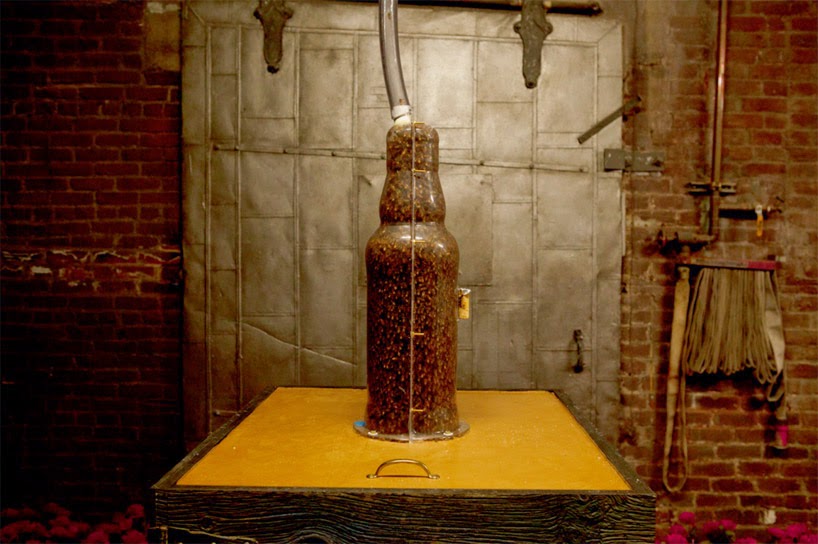 [Images: Courtesy of Dewar's, via designboom].
[Images: Courtesy of Dewar's, via designboom].These pictures tell the story clearly enough: using a large glass bottle as a mold in which the bees could create new hives, the process then ended with the removal of the glass and the revealing of a complete, bottle-shaped, "3D-printed" hive.
As Dewar's joked, it was 3B-printed.

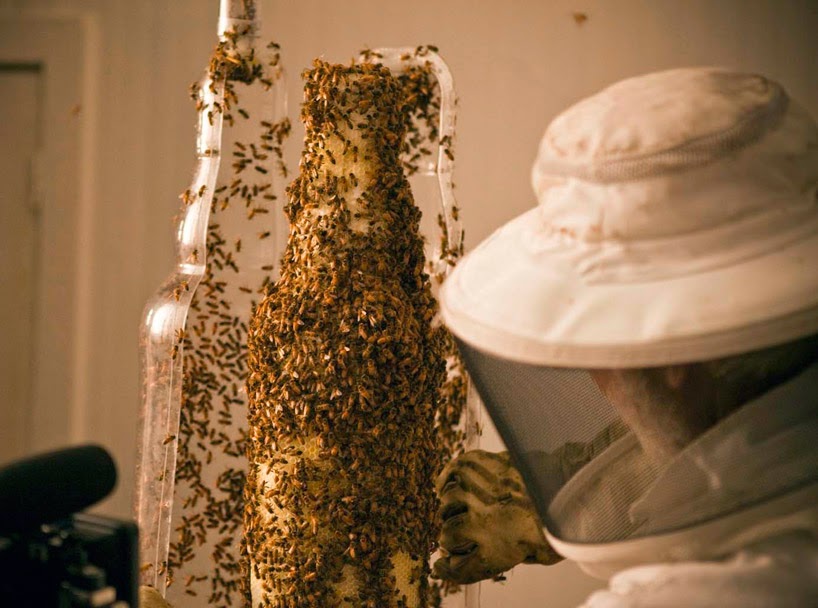
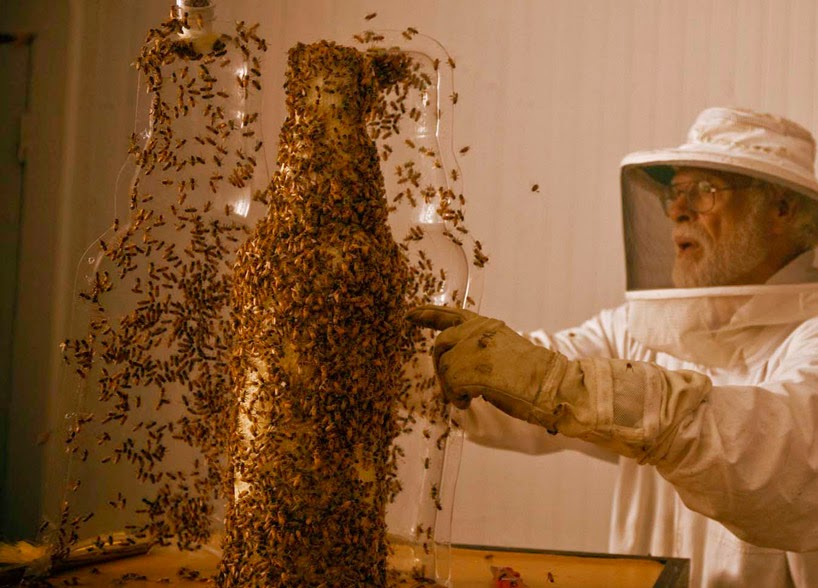 [Images: Courtesy of Dewar's, via designboom].
[Images: Courtesy of Dewar's, via designboom].Or take the Silk Pavilion, another recent project you've undoubtedly already seen, in which researchers at MIT, led by architect Neri Oxman, 3D-printed a room-sized dome using carefully guided silkworms as living printheads.
 [Image: Courtesy of MIT].
[Image: Courtesy of MIT].The Silk Pavilion was an architectural experiment in which the body of the silkworm, guided along a series of very specific paths, was "deployed as a biological printer in the creation of a secondary structure."
The primary structure, meanwhile—the pattern used by the silkworms as a kind of depositional substrate—was nothing more than a continuous thread wrapped around a metal scaffold like a labyrinth, seen in the image below.
 [Image: Courtesy of MIT].
[Image: Courtesy of MIT].It was at this point in the process that a "swarm of 6,500 silkworms was positioned at the bottom rim of the scaffold spinning flat non-woven silk patches as they locally reinforced the gaps across CNC-deposited silk fibers." In other words, they infested the labyrinth and laid down architecture with their passing.
 [Image: Courtesy of MIT].
[Image: Courtesy of MIT].The “CNSilk" method, as it was known, resulted in a gossamer, woven dome that looks more like a cloud than a building.
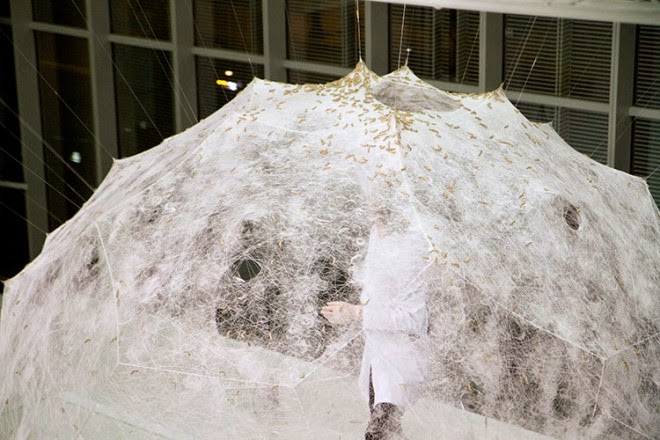
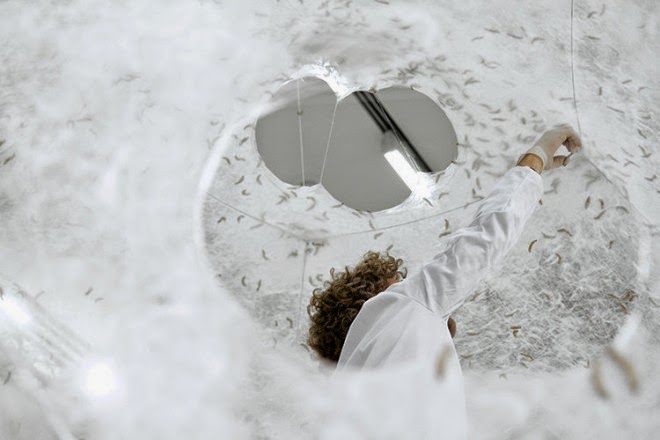 [Images: Courtesy of MIT].
[Images: Courtesy of MIT].What both of these examples demonstrate—despite the fact that one is a somewhat tongue-in-cheek media ploy by an alcohol company—is that animal bodies can, in fact, be guided, disciplined, or otherwise regulated to produce large-scale structures, from consumer objects to whole buildings.
After all, the very origins of architecture were a collaboration with animal bodies, and experiments like these only update those earliest constructions.
In both cases, however, the animals are simply depositing, or "printing," what they would normally (that is, naturally, in the absence of human augmentation) produce: silk and honey. Things get substantially more interesting, on the other hand, when we look at more exotic biological materials.
Bee Plastic
For half a decade or more, materials scientist Debbie Chachra at New England's Olin College of Engineering has been researching what's known as "bee plastic": a cellophane-like biopolymer produced by a species native to New England, called Colletes inaequalis.
These bees secrete tiny, cocoon-like structures in the soil—one such structure can be seen in the photo, below—using a special gland unique to its species. The resulting, non-fossil-fuel-based natural polyester not only resists biodegradation, it also survives the temperate extremes of New England, from the region's sweltering summers to its subzero winter storms.
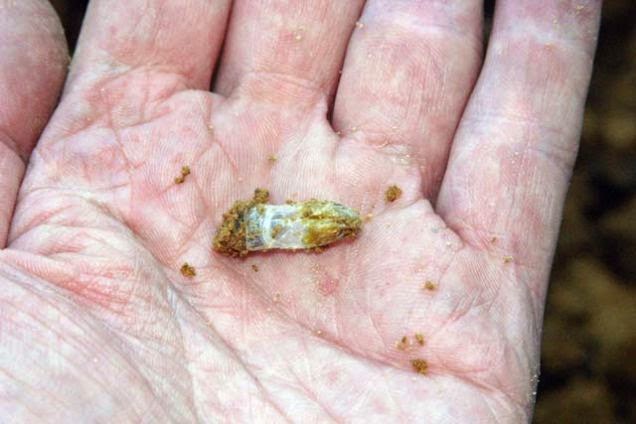 [Image: Courtesy of Deb Chachra].
[Image: Courtesy of Deb Chachra].More intriguingly, however, the cellophane-like bee plastic "doesn't come from petroleum," Chachra explained to me for a 2011 end-of-year article in Wired UK. "The bees are pretty much just eating pollen and producing this plastic," she continued, "and we're trying to understand how they do it."
Bee plastic, Chachra justifiably speculates, could perhaps someday be used to manufacture everything from office supplies to car bumpers, acting as an oil-free alternative to the plastics we use today. In the process, it could perhaps even kickstart a homegrown bio-industry for New England, where the species already thrives, wherein the very idea of a factory needs to be fundamentally reimagined.
The most exciting architectural possibilities here come less from the bees themselves and more from the elaborate structures that would be required to house their activities; imagine a brand new BMW factory somewhere in the suburbs of Boston populated only by plastic-producing bees, and you get some sense of where industrial manufacturing might go in an alternate future. Not unlike Dewar's bee-printed bottle, then, augmented cousins of Chachra's plastic-producing bees could thus 3D-print whole car bodies, kitchen counters, architectural parts, and other everyday products.
But even this, of course, is a vision of animal-based manufacturing that relies on the already-existent excretions of living creatures. Could we—temporarily putting aside the ethical implications of this, simply to discuss the material possibilities—perhaps genetically modify bees, silkworms, spiders, and so on to produce substantially more robust biopolymers, something not just strong enough to resist biodegrading but that could be produced and used on an industrial scale?
Recall, for example, that the U.S Army, working with a Canadian firm called Nexia Biotechnologies, was successful in its attempt to genetically engineer a goat that would produce spider-silk proteins in its milk. Incredibly, those "Biosteel goats," as they were later known, were eventually housed in old ammunition bunkers on a New York State military base, as if they were living bioweapons that needed to be held in quarantine.
 [Image: Biosteel goats summed-up in one simple equation (via)].
[Image: Biosteel goats summed-up in one simple equation (via)].The ultimate goal of producing these goats was to generate an unbreakable super-fiber that could be used in battle gear, including "lightweight body armor made of artificial spider silk," and other military armaments; but others have speculated that entire bridges or other pieces of urban infrastructure could someday be woven by goats.
These possibilities become even more strange and promising when we move to materials like concrete.
Concrete Honey
As part of an ongoing collaborative project, NYC-based designer John Becker and I have been looking at the possibility of using bees that have been genetically modified to print concrete. We could call them architectural printheads.
 [Image: By John Becker].
[Image: By John Becker].Initially inspired by a somewhat willful misreading of a project published under the title "Bees Make Concrete Honey," John and I began to imagine and illustrate a series of science-fictional scenarios in which a new urban bee species, called Apis caementicium—or cement bees—could be deployed throughout the city as a low-cost way to repair statues and fix architectural ornament, even to produce whole, free-standing structures, such as cathedrals.
 [Image: By John Becker].
[Image: By John Becker].In a process not unlike that used for the Dewar's bottle, above, the bees would be given an initial form to work within. Then, buzzing away inside this mold or cast, and additively depositing the ingredients for bio-concrete on the walls, frames, or structures they've been attached to, the bees could 3D-print new architectural forms into existence.
This includes, for example, the iconic stone lions found outside the New York Public Library; they've been damaged by exposure and human contact, but can now be fixed from within by concrete bees. Think this as a kind of organic caulking.
 [Image: By John Becker].
[Image: By John Becker].Yet tidy plots such as these invariably spin out of control and things don't quite go as planned.
Feral Printers
Predictably, these concrete bees eventually escape: first just a few here and there, but then an upstart colony takes hold elsewhere in the city. They breed, speciate, and expand.
Within a few years, as the bees reproduce and thrive, and as their increasingly far-flung colonies grow, people become aware of the scale of the problem: rogue 3D-printing bees have begun to infest the region.
 [Image: By John Becker].
[Image: By John Becker].They print where they shouldn't print and, without the direction of their carefully made formwork and molds, what they produce often makes no sense.
They print on signs and phone poles; they take over parks and gardens where they print strange forms on flowers, sealing orchids and roses in masonry shells. Bizarre gardens of hardened geometry form on windowsills and ledges, deep in urban forests and along railways and roads.
 [Image: By John Becker].
[Image: By John Becker].Tiny fragments of concrete can soon be seen atop plants and door frames, beneath cars and on chain-link fences, coiling up and consuming the sides of structures where they were never meant to be, like kudzu; and, of course, strange bee bodies are found now and again, these little concrete-laden corpses lying in the deep grass of backyards, on parking lots and rooftops.
 [Image: By John Becker].
[Image: By John Becker].Their fallen bodies, augmented and extraordinary, thus dot the very city they've also beautified and improved—this place where they once printed church steeples and apartment ornament, where they fixed cracked statues, sidewalks, and walls.
Of course, other, more adventurous or simply disoriented bees make their way further, hitching inadvertent rides in the holds of planes and cargo ships, mistakenly joining other hives then shipped around the world.
The bees are soon found in Europe, China, and—for reasons never quite clear to materials scientists—throughout India, where, as in the sample image below, they can be seen adding unnecessary ornamentation to temples in Rajasthan. Swarming and uncountable, they busily speck the outside of the building with bulbous and tumid additions no architect would ever have planned.
 [Image: By John Becker].
[Image: By John Becker].As the bees speciate yet further, and their concrete itself begins to mutate—in some cases, so hard it can only be removed by the toughest drills and demolition equipment, other times more like a slow-drying sandstone incapable of achieving any structure at all—this experiment in animal printheads, these living 3D printers producing architecture and industrial objects, comes to end.
A Bee Amidst The Machines
Most designers learn from the—in retrospect—obvious mistakes that led to these feral printers, returning to more easily controlled inorganic factories and industrial processes. But, even then, on quiet spring days, a tiny buzzing sound can occasionally be heard beneath someone's front porch, out in the suburban gardens somewhere, deep inside National Parks, and even inside huge machines, where whole automobile assembly lines come shuddering to a halt.
There, within the gears, just doing what it's used to doing—what we made it do—a tiny family of 3D-printing bees has taken root, leaving errant clumps of concrete wherever they alight.
(Thanks to John Becker for the fun. An earlier version of this post was previously published on Gizmodo).
Giant Creature 3D Printed

Some folks have 3D printed a truly gigantic monster that might be one the largest 3D prints ever attempted.
There may be larger prints performed by experimental outdoor concrete 3D printers, but the “BodocK” was produced with plain old industrial 3D printers. It’s a collaboration between Legacy Effects, the Stan Winston School of Character Arts and Stratasys, who together made Bodock.
Bodock is a character indeed. It’s a spectacular sight to behold, as it is 4.1m (13.5 feet) tall and 3m (9 feet 9 inches) wide. We’re not certain how heavy it is, but it likely requires a crew of monster-sized individuals to move around. However, in the video you’ll quickly notice that it moves by itself.
How was it made? Apparently different types of Stratasys gear were used, including their massive Fortus 900mc, which can deposit extruded plastic up to 910 x 610 x 910mm (36 x 24 x 36 inches). We wouldn’t be surprised if Stratasys’ latest Object Connex 500 color 3D printer was also used to create some of the colorful details.
Fabbaloo friend and Legacy Effects Lead Systems Engineer Jason Lopes says:
The true value of using Stratasys 3D printing on the Bodock project was the time savings – being able to go directly from design to the end use part without having to add additional steps in the process. This is a huge step forward for Legacy Effects in incorporating 3D printing for end use materials in their designs. Never have we used such a large scale of directly 3D printed parts on a project of this scope and magnitude. This truly showcases the strength of this material and the ease of post-processing and finishing.
Legacy Effects is well-known for their incredible ability to create amazing characters, which no doubt you’ve seen in many popular recent films.
Why build this item? It’s a promotional piece to be displayed at the San Diego Comic Con, which just happens to open today.
Via Stratasys
NASA Releases Many Printable 3D Models

The US space agency NASA has released two dozen printable 3D models of spacecraft and alien worlds.
A page at NASA’s website now holds around two dozen 3D models of contemporary interplanetary spacecraft, asteroids and planetary surfaces. Among the spacecraft are Cassini, Dawn, Kepler, Messenger, Pioneer, Rosetta and many more.
There are a few planetary bodies in the small collection, including the asteroid Eros, shown above. Also available are the asteroid Itokawa, the dwarf planet Vesta and surfaces of the Moon and Mars. These models are incredibly detailed and should print very well. Even better, NASA has pre-cut them into printable pieces, as you can see above - although from a distance the print might not look like something other than an asteroid.

The actual printability of the spacecraft models is questionable, as most of them include many extremely spindly parts, like long protruding antennae. It’s pretty clear to us that those parts are almost impossible to print, even with support structures: removal of the support structures would likely snap the very small antennae. Printing them on industrial 3D printers would also be quite challenging. Nevertheless, you still may be able to print the main spacecraft bodies.
We’re hugely pleased that NASA has done this. They’ve been collecting massive amounts of 3D data on our solar system and it’s been curious why they haven’t released it in this way. But now they have, and they’ve done it in just the right way to address the needs of the 3D print community.
Now, do we have any gray filament left?
Via NASA
Stunning Photo-Realistic Graphite Drawings by Monica Lee










left: the girl with glasses by Marteline Nystad | right: Monica Lee’s illustration of the photograph
Malaysian artist Monica Lee is obsessed with details. But then again, I guess you have to be in order to create some of the most stunning photo-realistic drawings we’ve ever seen. “I like to challenge myself with complex portraits especially people with freckles or beard,” says Lee, who often works from photographic portraits to create seemingly identical drawings. Surprisingly, Lee worked in the digital world for 12 years before making the jump to illustration. But it certainly doesn’t show. She now spends 3-4 weeks on a single drawing. The artist attributes her love for hyperrealism to her father, who worked in the field of photography. You can follow Monica Lee on Facebook or Instagram. She also sells her complex drawings as smartphone cases. (via IGNANT)
Brave New Now
Brave New Now is a collection of specially commissioned short stories set in a fictional future city developed by speculative architect Liam Young for the 2013 Lisbon Architecture Triennale. Authors have been invited to inhabit the city, to breathe life into its characters and cultures and give form to its streets and spaces through narrative. . . .
image: Hovig ALAHAIDOYAN.
It is a speculative urbanism, an exaggerated present, in which we can imagine the wonders and possibilities of emerging biological and technological research.
“A projective fiction is a critical tool that is both an extraordinary vision of tomorrow and a provocative examination of the pertinent questions facing us today.” — Liam Young
This digital publication was commissioned by “Close, Closer” chief curator Beatrice Galilee, Art Direction by Zak Group, and graphic design by Raquel Pinto.
*The support of The British Council has enabled a discounted distribution price of Brave New Now ebook.
Editor: Liam Young
Authors: Warren Ellis, Tim Maughan, Jonathan Dotse, Bruce Sterling, Rachel Armstrong, Samit Basu, Anil Menon.
Photographers: Michael Wolf, Greg Girard, Neil Chowdhury, Vincent Fournier, Thomas Weinberger, Charlie Koolhaas, Greg White, Daniel Beltrá, Victoria Sambunaris, Christina Seely, Brice Richard, Bas Princen.
Concept Art: Hoving Alahaidoyan, Daniel Dociu.
Make Your Own 3D Printer Filament with the ExtrusionBot

There have been several attempts at developing a practical filament-making machine. Is ExtrusionBot the one that succeeds?
We’ve looked at a few similar devices and found most of them to be impractical for various reasons, not the least being quality of output. In today’s personal 3D printers (at least the plastic filament-based ones) the quality of input filament is critical. It must have highly consistent diameter, no air bubbles, consistent coloration, consistent chemistry for strength and be non-toxic. Any usable filament maker must be able to produce those results or it won’t be worth your trouble.
Let’s take a look at the ExtrusionBot, said to be “The world’s fastest filament extruder”. At a scary 4 feet per seconds (1.22 m/s), you’d think so - and stand clear of the machine, too. We suspect that there are industrial machines that can beat this mark, but we would believe the ExtrusionBot could be the world’s fastest PERSONAL filament extruder.
The ExtrusionBot has a unique design: it’s upright, whereas most of the other filament makers we’ve seen are horizontal and take up much more space. We suspect this could be the optimum design, as gravity can assist in the speed and by dropping filament vertically it avoids natural bending that may occur.
Also unlike many other filament makers, the ExtrusionBot includes an “automatic spooling mechanism so filament does not end up as a tangled mess on the floor”. This alone makes the ExtrusionBot better. We have been very surprised that other filament making machines’ designers have often ignored this critical feature.
The ExtrusionBot includes several other interesting features:
- Swappable nozzles to enable extrusion of different filament diameters.
- Temperature sensor to automatically stop if trouble is detected.
- Metal components for high temperature use.
- Worldwide shipping.
- Fully assembled.
Of course, the major benefit of making your own filament is low cost materials. According to ExtrusionBot, you can make a 1kg spool of PLA for as low as USD$4, some ten times less than typical pricing. And you can control the coloration yourself.
The ExtrusionBot is available today for USD$625. That might sound like a lot of money if you’re using a 3D printer that costs about that same amount, but let’s check out the math: If you can save USD$40 per spool, you’ll need to create and use around 16 spools to break even.
For some of us, that’s not too hard.
Via ExtrusionBot (Hat tip to Andrew)
A Fully Mechanical 3D Printer? Yes, It Exists

It has been proven: a rudimentary 3D printer has been built solely from mechanical components - with no electronics involved.
Dutch artist and maker Daniel de Bruin created this startling mechanical creature he calls “this new technology” as a work of art. He says:
3d printing allows me to create products more swiftly and more efficiently than ever. but these products are not mine. they are merely a product of this new technology. I love technology but how can I reclaim ownership of my work? perhaps by building the machine that produces the work. perhaps by physically powering the machine, which I built, that produces the work. in hopes of rediscovering the sense of having created something, I create.
The machine operates by gravity. Some 15kg of metal weights pull a chain that powers all the moving parts of the machine, including the extruder, speed governor, z-axis and print plate spinner. Wait a sec, what are those? The speed governor appears to be a fan-like structure in the rear that uses air resistance to moderate the speed of the machine. The plate spinner, well, spins the print plate, eliminating the need for old-fashioned X and Y axis movements.
You might ask how the machine knows what to print, as there are no electronics to read SD cards, no WiFi to listen for GCODE streams. Instead, the “3D model” is in fact a simple aluminum wire from which the diameter of each layer is read in an analog fashion. Bending the wire provides a different shape. It’s much like a “Lathe” tool found in 3D modeling software, except this one is in real life!

Material options on this machine seem to be limited to room-temperature squishy stuff, as the extruder is a syringe driven by the limited force of gravity.
This design is never going to show up in people’s homes or workshops, but it does demonstrate the possibilities of analog design.
Via Daniel de Bruin

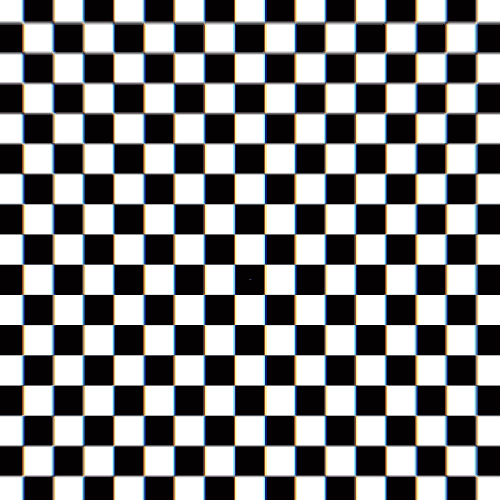

![goat-multiverse-combo[1]](http://amultiverse.com/wp-content/uploads/2014/02/goat-multiverse-combo1-450x259.jpg)


